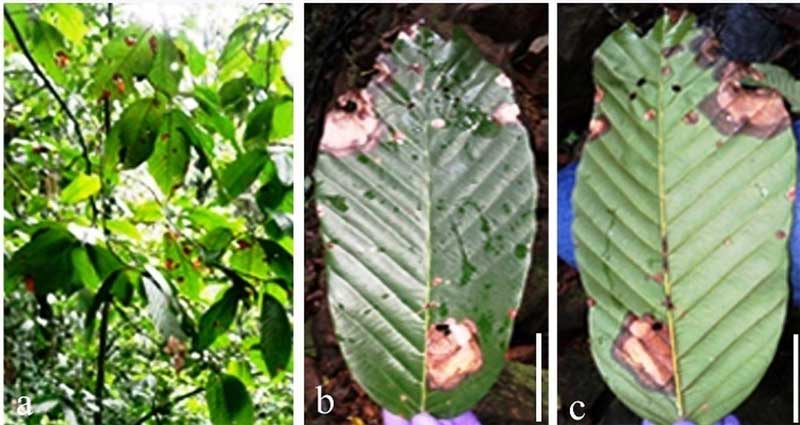

A newly emerging fungal disease is posing a serious threat to Dipterocarpus bourdillonii, a critically endangered tree species endemic to the Western Ghats. Scientists have identified Corynespora cassiicola, an aggressive phytopathogen known for its vast host range, as the causal agent of a fast-spreading leaf spot and blight disease affecting this rare rainforest tree. The discovery has triggered an urgent call for integrated conservation and disease surveillance measures to protect one of India’s most ecologically valuable and vulnerable plant species.
Dipterocarpus bourdillonii, belonging to the family Dipterocarpaceae, is listed as critically endangered on the IUCN Red List. This tall, canopy-forming tree is found only in the evergreen rainforests of Kerala and plays a vital ecological role by maintaining forest structure and supporting a wide array of biodiversity. Economically, its durable hardwood has long been valued for use in construction and furniture, while its oleoresin has traditional medicinal and industrial significance. However, due to decades of overexploitation and habitat degradation, the species’ population has been severely reduced. The recent emergence of this new fungal threat adds another layer of urgency to the conservation of the species.
Corynespora cassiicola is a globally distributed fungal pathogen that affects over 530 plant species, including crops like rubber, cotton, soybean, tomato, cucumber, and a variety of ornamental and medicinal plants. It thrives in warm, humid conditions—ideal environments like the Western Ghats—and spreads through conidia (spores) carried by wind, water, and human activity. The fungus causes distinct target-shaped necrotic lesions on leaves, often bordered by yellow halos, which can lead to premature leaf drop, reduced photosynthesis, blight, and even death of the host plant in severe cases. On fruits, it causes sunken brown flecks that grow darker and cracked over time.
Its infection of D. bourdillonii was confirmed through detailed morphological and molecular analyses, a critical step in ensuring accurate diagnosis and understanding of its epidemiology. According to Mr. Kumar, one of the scientists involved in the study, molecular identification techniques are essential for distinguishing C. cassiicola from other visually similar pathogens, thereby enabling timely management interventions. This research not only enhances disease detection capabilities but also contributes to broader forest health monitoring and conservation planning, both in situ and ex-situ.
Managing this aggressive pathogen poses a significant challenge. While fungicides such as mancozeb and azoxystrobin may offer some control, C. cassiicola is genetically diverse, and resistance to several fungicides, particularly quinone outside inhibitors (QoIs) and benzimidazoles, has already been observed in various regions. Moreover, the development of resistant plant varieties is complicated by the fungus’s variable host specificity and aggressive adaptability. Cultural practices such as maintaining proper plant spacing, removing infected plant material, crop rotation, and ensuring good field sanitation are essential components of an integrated disease management approach.
Beyond its impact on plants, C. cassiicola has been occasionally isolated from nematodes and even human skin, causing rare cases of subcutaneous phaeohyphomycosis, primarily in immunocompromised individuals. These cases, though uncommon, point to the pathogen’s ability to interact with a broad range of organisms, underscoring its adaptive potential and public health relevance in agricultural zones.
The threat posed by C. cassiicola to Dipterocarpus bourdillonii highlights the need for urgent action to conserve endangered plant species in biodiversity hotspots like the Western Ghats, which are already reeling under anthropogenic pressures such as deforestation, habitat fragmentation, and climate change. As much of the remaining habitat of D. bourdillonii lies outside protected areas, conservation efforts must be expanded beyond traditional forest boundaries, incorporating local communities, stricter regulation of land use, and coordinated research to monitor emerging pathogens.
This alarming development serves as a reminder that plant diseases can significantly accelerate biodiversity loss, especially among species already on the brink of extinction. Preserving the health of keystone and endangered species like D. bourdillonii is not just an ecological priority, but a necessity for sustaining the overall integrity of rainforest ecosystems in India and beyond.
Published on: Saturday, July 5, 2025